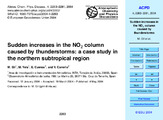Por favor, use este identificador para citar o enlazar este ítem:
http://hdl.handle.net/20.500.11765/378
Sudden increases in the NO2 column caused by thunderstorms: a case study in the northern subtropical region [Discussion paper]
Registro completo de metadatos
| Campo DC | Valor | Lengua/Idioma |
|---|---|---|
| dc.contributor.author | Gil-Ojeda, Manuel | - |
| dc.contributor.author | Yela González, Margarita | - |
| dc.contributor.author | Cuevas Agulló, Emilio | - |
| dc.contributor.author | Carreño Corbella, Virgilio | - |
| dc.date.accessioned | 2015-12-03T09:09:02Z | - |
| dc.date.available | 2015-12-03T09:09:02Z | - |
| dc.date.issued | 2004 | - |
| dc.identifier.citation | Atmospheric Chemistry and Physics Discussions [Preprint]. 2004, 4(3), p. 2263-2281 | es_ES |
| dc.identifier.issn | 1680-7367 | - |
| dc.identifier.issn | 1680-7375 | - |
| dc.identifier.uri | http://hdl.handle.net/20.500.11765/378 | - |
| dc.description.abstract | A long-term program for NO2 column measurements started in 1993 at the subtropical Izaña Observatory (28° N, 16° W). Seasonal evolution shows a small day-to-day variability as compared with higher latitudes. Sharp increases in the column appear occasionally superimposed on the annual cycle. The origin of these spikes is explored by considering the possibility of tropospheric transport from polluted areas, stratospheric intrusions, meridional transport in the stratosphere and production by lightning, in a case study. From radiative transfer calculations and meteorological information available, it is shown that the NO2 increase takes place in the upper troposphere with values of 300–400 pptv. Back-trajectories reveal that, for the case studied, the air masses came from an area of thunderstorms located upwind. After the analysis of the various possibilities, the NO2 increase by lightning production appears to be the most feasible cause. Annual distribution of spikes displays a maximum in late winter and spring during the shift from midlatitude winter tropopause to summer tropopause. | es_ES |
| dc.description.sponsorship | This work has been partially supported by the EU QUILT Project (EVK2- 25 CT2000-0059). The back-trajectories were computed with the NDSC Data Host Facility (DHF) at NOAA/NCEP. | - |
| dc.format | application/pdf | - |
| dc.language.iso | eng | es_ES |
| dc.publisher | European Geosciences Union | es_ES |
| dc.subject | NO2 column | es_ES |
| dc.subject | Thunderstorms | es_ES |
| dc.subject | Tropospheric transport | es_ES |
| dc.subject | Air masses | es_ES |
| dc.title | Sudden increases in the NO2 column caused by thunderstorms: a case study in the northern subtropical region [Discussion paper] | es_ES |
| dc.type | info:eu-repo/semantics/preprint | es_ES |
| dc.relation.publisherversion | https://dx.doi.org/10.5194/acpd-4-2263-2004 | - |
| dc.rights.accessRights | info:eu-repo/semantics/openAccess | - |
| Colecciones: | Artículos científicos 2000-2004 | |
Ficheros en este ítem:
| Fichero | Descripción | Tamaño | Formato | ||
|---|---|---|---|---|---|
| acpd-4-2263-2004.pdf | 846,38 kB | Adobe PDF |  Visualizar/Abrir |
Los ítems de Arcimis están protegidos por una Licencia Creative Commons, salvo que se indique lo contrario.





